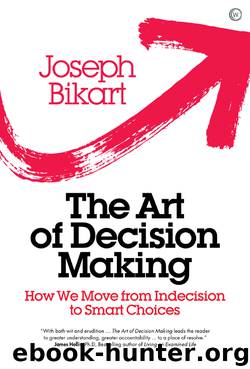The Art of Decision Making by Joseph Bikart

Author:Joseph Bikart
Language: eng
Format: epub
Publisher: Watkins Media
PART III
THE MOMENTUM
OF DECISIVENESS
CHAPTER 7
OF THE ESSENCE
“It is the same with people as it is with riding a bike. Only when moving can one comfortably maintain one’s balance”.
Albert Einstein, in a letter to his son Eduard, 1930
Why dedicate the penultimate part of this book to the Momentum of Decisiveness, rather than jump directly to the main object of our pursuit, the Deciding Mind and how we make our smartest decisions?
The answer is that in this book we are patiently moving one step at a time. We have uncovered the potential motivations not to make a decision, and the reasons why we might get stuck. Now we turn to look at the engine of decision making.
Momentum is what drives our choices across the six chambers of decision making through to their realization. How does this happen? And how can we favour the conditions of momentum?
This new stretch of the road is not without its own perils. These are not outside obstacles, such as another person’s will: they are invisible inner obstacles, which only manifest themselves when momentum is reduced or absent.
Often a project might start well and engage us, but we find that we lose appetite later on, for no obvious reason. As a result, we become less interested in the work we have to do, and end up stalling it.
This is reminiscent of the story of Hannibal, the 3rd-century bc Carthaginian general, who dedicated his life to vanquishing the Roman Empire. Hannibal came very close to this objective following his victory in Cannae, one of the defining battles of the Second Punic War. One by one, several strongholds defected from Rome to Carthage. As the Roman historian Livy wrote, “How much more serious was the defeat of Cannae than those that preceded it can be seen by the behaviour of Rome’s allies.
Before that fateful day, their loyalty remained unshaken. Now it began to waver for the simple reason that they despaired of Roman power.”
At this stage, nothing seemed to stand in the way of Hannibal’s eventual victory … except for one important detail: momentum.
Instead of forging through to Rome and displaying the same resolve with which he had led his armies (complete with 37 elephants) first through Spain and Gaul, then through the Alps, and victoriously all the way to southern Italy, Hannibal decided to regroup in his newly established base at Capua before the final attack on Rome.
One of Hannibal’s key generals urged him to march without delay toward Rome, but he rejected the advice. This interruption in the hitherto successful war momentum would prove to be the Carthaginians’ undoing.
In popular culture this sojourn in Capua stands for the misjudged interruption of an effort, combined with unwarranted self-confidence – and also for a doomed indulgence in the good life. Capua fell back to the Romans, and Hannibal was recalled to Carthage to face more military defeats, which ultimately led to his voluntary exile.
The longevity of this story through two millennia is testimony to its eloquent illustration of the risks we face whenever we lose momentum.
Download
This site does not store any files on its server. We only index and link to content provided by other sites. Please contact the content providers to delete copyright contents if any and email us, we'll remove relevant links or contents immediately.
The Art of Thinking Clearly by Rolf Dobelli(10219)
Mindhunter: Inside the FBI's Elite Serial Crime Unit by John E. Douglas & Mark Olshaker(9200)
Change Your Questions, Change Your Life by Marilee Adams(7635)
Nudge - Improving Decisions about Health, Wealth, and Happiness by Thaler Sunstein(7615)
Mastermind: How to Think Like Sherlock Holmes by Maria Konnikova(7227)
The Power of Now: A Guide to Spiritual Enlightenment by Eckhart Tolle(5605)
Men In Love by Nancy Friday(5155)
Altered Sensations by David Pantalony(5045)
Factfulness: Ten Reasons We're Wrong About the World – and Why Things Are Better Than You Think by Hans Rosling(4694)
The Confidence Code by Katty Kay(4187)
Thinking in Bets by Annie Duke(4152)
Man and His Symbols by Carl Gustav Jung(4067)
The Worm at the Core by Sheldon Solomon(3433)
Why Buddhism is True by Robert Wright(3403)
Liar's Poker by Michael Lewis(3368)
Three Women by Lisa Taddeo(3354)
The Inner Life of Animals by Peter Wohlleben(3259)
Descartes' Error by Antonio Damasio(3230)
How Music Works by David Byrne(3186)
